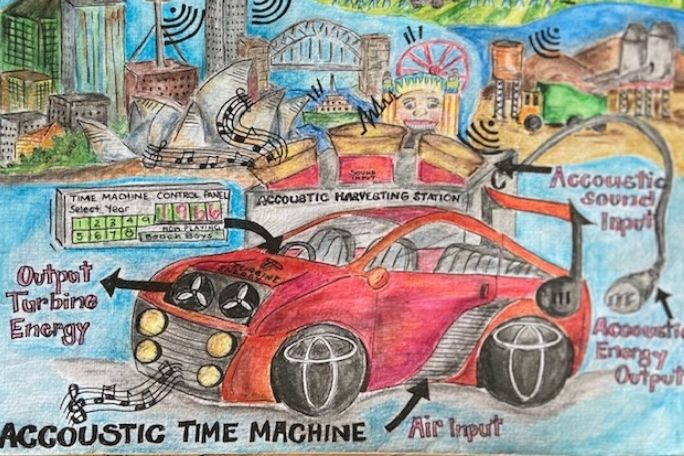Lesson summary
In this lesson, students design a dream car and create an artwork to represent their ideas that will be submitted to the Toyota Dream Car Art Contest. This contest encourages and inspires creative expression and imagination in students – some amazing ideas are born from dreams! Students will begin by reviewing their understanding of sustainability, before investigating what natural resources are and how we use them. Students will then participate in group work activities to think about how we could use resources more sustainably in different settings, before designing a dream car that could help people use resources more sustainably.
Learning intentions:
Students will...
- understand what sustainability is
- understand what natural resources are, how we use them and how and why they should be used more sustainably
- understand how to communicate a message through art
- develop and practise art-making techniques
Success criteria:
Students can...
- define sustainability in their own words
- explain what natural resources are and how to use them sustainably
- conduct research online
- work collaboratively
- plan and create artworks
- use different drawing/painting techniques
- engage in group and class discussion.
Lesson guides and printables
Lesson details
Curriculum mapping
Australian curriculum content descriptions:
Year 7 Science:
- Some of Earth’s resources are renewable, including water that cycles through the environment, but others are non-renewable (ACSSU116)
- Solutions to contemporary issues that are found using science and technology, may impact on other areas of society and may involve ethical considerations (ACSHE120)
- Communicate ideas, findings and evidence based solutions to problems using scientific language, and representations, using digital technologies as appropriate (ACSIS133)
Year 8 Science:
- Solutions to contemporary issues that are found using science and technology, may impact on other areas of society and may involve ethical considerations (ACSHE135)
- Communicate ideas, findings and evidence based solutions to problems using scientific language, and representations, using digital technologies as appropriate (ACSIS148)
Years 7 & 8 Visual Arts:
- Experiment with visual arts conventions and techniques, including exploration of techniques used by Aboriginal and Torres Strait Islander artists, to represent a theme, concept or idea in their artwork (ACAVAM118)
- Practise techniques and processes to enhance representation of ideas in their art-making (ACAVAM121)
Syllabus outcomes: SC4-12ES, SC4-11PW, SC4-9WS, VAS3.1, VAS3.2.
General capabilities: Critical and creative thinking.
Cross-curriculum priority: Sustainability OI.7.
Relevant parts of Year 7 Science achievement standards: Students analyse how the sustainable use of resources depends on the way they are formed. They communicate their ideas, methods and findings using scientific language and appropriate representations.
Relevant parts of Year 8 Science achievement standards: Students use appropriate language and representations to communicate science ideas, methods and findings in a range of text types.
Relevant parts of Year 7 and 8 Visual Arts achievement standards: Students plan their art making in response to exploration of techniques and processes used in their own and others’ artworks. They demonstrate use of visual conventions, techniques and processes to communicate meaning in their artworks.
Unit of work: Toyota Dream Car Contest.
Time required: 160+ mins – artwork could be completed as homework.
Level of teacher scaffolding: Medium – facilitate class discussion, guide groups through activities and through the creation of artworks.
Resources required
- Paper measuring no larger than 400mm x 550 mm (15.7-21.7in.) or A3 in size
- Butcher’s paper and scrap paper for drafting
- Drawing materials, including but not limited to: coloured pencils, pens/markers, crayons, paints, watercolour paints, etc
- Student Worksheets – one copy per student
- Device capable of presenting a video to the class
- Definitions of Sustainability Factsheet (optional – one copy per student)
- Sustainability Factsheet – secondary (teacher copy)
- Previous contest winners (equipment to project)
Skills
This lesson is designed to build students’ competencies in the following skills:
- Collaboration
- Communication
- Creativity
- Critical thinking
- Problem solving
Additional info
The Toyota Dream Car Art Contest usually commences late October to early November and concludes late to early March. Find up-to-date entry details, prizes and full terms and conditions here.


Welcome back!
Don't have an account yet?
Log in with:
By signing up to Cool.org you consent and agree to Cool's privacy policy to
store, manage and process your personal information. To read more, please see
our privacy policy here(Opens in new tab).
Create your free Cool.org account.
Many of our resources are free, with an option to upgrade to Cool+ for premium content.
Already have an account?
Sign up with:
By signing up to Cool.org you consent and agree to Cool's privacy policy to
store, manage and process your personal information. To read more, please see
our privacy policy here(Opens in new tab).